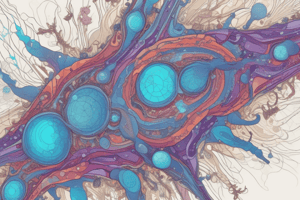Podcast
Questions and Answers
What is the function of the eyepiece?
What is the function of the eyepiece?
- To hold the objective lenses
- To support the tube
- To look through and magnify the specimen (correct)
- To connect the base to the arm
What does the tube of a microscope do?
What does the tube of a microscope do?
Connects the eyepiece to the objective lenses.
What is the purpose of the arm in a microscope?
What is the purpose of the arm in a microscope?
Supports the tube and connects it to the base.
What is the base of a microscope used for?
What is the base of a microscope used for?
What is an illuminator in a microscope?
What is an illuminator in a microscope?
What does the stage do in a microscope?
What does the stage do in a microscope?
What is the function of the revolving nosepiece/turret?
What is the function of the revolving nosepiece/turret?
What powers do objective lenses typically have?
What powers do objective lenses typically have?
What does the rack stop do?
What does the rack stop do?
What is the purpose of the condenser lens?
What is the purpose of the condenser lens?
What is the diaphragm/iris used for in a microscope?
What is the diaphragm/iris used for in a microscope?
What is the coarse adjustment knob used for?
What is the coarse adjustment knob used for?
What does the fine adjustment knob do?
What does the fine adjustment knob do?
What are stage clips used for?
What are stage clips used for?
What is the aperture in a microscope?
What is the aperture in a microscope?
Flashcards
Eyepiece
Eyepiece
The lens you look through that magnifies the specimen.
Microscope Tube
Microscope Tube
Connects the eyepiece to the objective lenses.
Arm of Microscope
Arm of Microscope
Supports the tube and connects it to the base.
Base of Microscope
Base of Microscope
Signup and view all the flashcards
Illuminator
Illuminator
Signup and view all the flashcards
Stage
Stage
Signup and view all the flashcards
Revolving Nosepiece
Revolving Nosepiece
Signup and view all the flashcards
Objective Lenses
Objective Lenses
Signup and view all the flashcards
Rack Stop
Rack Stop
Signup and view all the flashcards
Condenser Lens
Condenser Lens
Signup and view all the flashcards
Diaphragm/Iris
Diaphragm/Iris
Signup and view all the flashcards
Coarse Adjustment Knob
Coarse Adjustment Knob
Signup and view all the flashcards
Fine Adjustment Knob
Fine Adjustment Knob
Signup and view all the flashcards
Stage Clips
Stage Clips
Signup and view all the flashcards
Aperture
Aperture
Signup and view all the flashcards
Study Notes
Microscope Parts and Functions
- Eyepiece: Lens located at the top of the microscope, with magnification powers typically at 10X or 15X.
- Tube: Connects the eyepiece to the objective lenses, forming the optical pathway for the image.
- Arm: Provides support for the tube and connects it to the base, enhancing stability during use.
- Base: The bottom structural component of the microscope that supports the entire apparatus.
- Illuminator: A consistent light source that replaces traditional mirrors for specimen illumination.
- Stage: A flat platform for placing slides, equipped with stage clips to secure them during observation.
- Revolving Nosepiece/Turret: Houses multiple objective lenses; facilitates easy rotation to switch magnification powers.
- Objective Lenses: Typically includes lenses of 4X, 10X, 40X, and 100X, producing total magnifications of up to 1000X when paired with a 10X eyepiece.
- Rack Stop: An adjustable feature that controls the minimum distance between the objective lens and the slide to prevent damage.
- Condenser Lens: Focuses light onto the specimen, improving illumination for better visibility.
- Diaphragm/Iris: Adjusts the intensity and size of the light beam directed upwards onto the slide, impacting image clarity.
- Coarse Adjustment Knob: A large knob for initial focusing; may move the stage or the upper part of the microscope for rapid adjustments.
- Fine Adjustment Knob: A smaller knob used for precise focusing after initial adjustments, ensuring sharp image clarity.
- Stage Clips: Keep slides securely in place on the stage to prevent movement during observations.
- Aperture: Opening in the stage that allows light to pass through for enhanced specimen viewing.
Studying That Suits You
Use AI to generate personalized quizzes and flashcards to suit your learning preferences.




